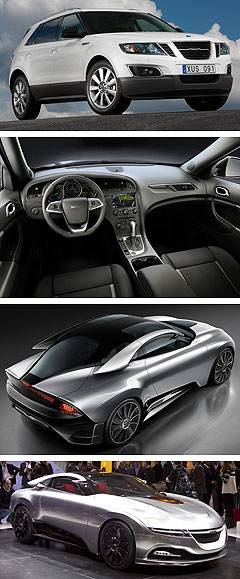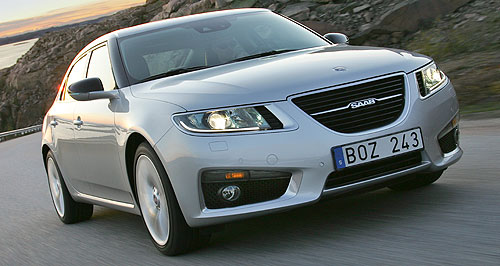Future models - Saab - 9-5Saab looks beyond 9-5Flagship: Saab's new 9-5 is set to be released in Australia later next week. More details on all-new 92 and next 9-3 emerge on the eve of Saab’s local 9-5 launch1 Apr 2011 SAAB has revealed more details about a range of upcoming models, including the all-new 92 compact car and its next-generation 9-3, on the eve of launching its new 9-5 flagship in Australia. The revitalised Swedish car-maker, which recommenced production as an independent company after being sold by General Motors last year, has also refuted reports it remains in financial strife after halting production this week due to a pay dispute with one of its suppliers. Four variants of the new-generation 9-5 sedan – Saab’s first all-new large car in more than 13 years – will be released in Australia late next week, including entry-level Vector and top-shelf Aero grades powered by turbocharged petrol and diesel engines. Opening the Australian 9-5 range, which will join the fresh MY11 9-3 and new 9-3X line-up that last month arrived in a new national retail network comprising eight dealerships, will be the 9-5 Vector 2.0T sedan, powered by a 162kW twin-scroll turbocharged direct-injection 2.0-litre four-cylinder petrol engine. Also matched as standard with a six-speed automatic transmission will be the 9-5 Vector 2.0TiDS sedan, powered by an 118kW 2.0-litre turbo-diesel and also equipped with 17-inch alloy wheels, Xenon headlights, foglights and powered front seats as standard. Topping the new 9-5 four-door range will be a pair of all-wheel drive Aero models riding on 19-inch alloys and available with either the 162kW turbo-petrol four in the Aero 2.0T XWD or a 221kW 2.8-litre turbo-petrol V6 for the Aero 2.8TS XWD. As we’ve reported, the newly established factory-owned local distributor, Saab Cars Australia, will also introduce the redesigned 9-5 Estate and facelifted MY12 9-3 range – both of which made their world debuts at the last month’s Geneva motor show – late this year, before releasing the all-new 9-4X crossover by early 2012.  Left: Saab 9-4X. Below: Phoenix concept from Geneva show. Left: Saab 9-4X. Below: Phoenix concept from Geneva show.Now, however, Saab Automobile president and CEO Jan Ake Jonsson has revealed further details about a range of all-new future Saab models in an interview with subscription news service automotiveworld.com, which was done before he announced his retirement (effective from May 19) last week. Mr Jonsson, a 38-year Saab veteran who will continue as a consultant until September, said there would not be a diesel version of the 9-4X, which is based on the Cadillac SRX, because it is an SUV directed primarily at petrol markets. “Unfortunately that (a 9-4X diesel) won’t be the case,” he said. “We could probably double our sales volume of the 9-4X in Europe with a diesel. But the 9-4X is really a vehicle for markets like the US, Russia, China and Australia, where gasoline is the traditional buyer preference.” Instead, the 9-4X will be produced with GM-sourced 3.0-litre and turbocharged 2.8-litre petrol V6 engines, and Mr Jonsson said Saab had not decided whether to follow GM’s lead in offering a version powered by the Holden Commodore’s 3.6-litre V6. “GM is going to put a 3.6-litre V6 into the SRX to replace the 2.8-litre turbo V6,” he said. “We have the option to take that engine too but we haven’t yet decided if we want to do that. So just as we have said previously, we will launch the 9-4X with two V6 engines: a 3.0-litre and a 2.8-litre turbo.” Mr Jonsson said Saab considered renaming its new 9-5 and next-generation 9-3, to be based on an all-new platform previewed underneath the Phoenix concept at Geneva, and confirmed the latter would not be produced alongside the current model. “The new 9-3 will be a dramatic difference compared to the existing car and we plan to do a straight cut-off for the changeover. The 9-3 is a rival for the Audi A4 and it will stay that way, just as the 9-5 competes against cars like the Audi A6. “In fact, we did have a discussion about perhaps changing the name of one of our cars but that was maybe calling the 9-5 the 9-6 and in that way declare that this was a step up from the old 9-5. But in the end, we decided to keep the name and we’ll do that for the 9-3 as well.” The outgoing Saab chief said the next 9-3, which will incorporate chassis components supplied by ZF, would employ a 1.6-litre BMW engine as part of a powertrain supply deal with the Bavarian maker, but confirmed the 9-5 would stick with GM engines. “For the new 9-3 (we will use the BMW engine),” said Mr Jonsson. “But for the 9-5, we are very happy with our GM powertrains. Having said that, we have flexibility with our engine strategy so we will see how it works out with the BMW engine in the next 9-3 and we will take it from there. “BMW is an easy organisation to work with. I was last with the executives we are dealing with two weeks ago and we speak to each other all the time. For them, it makes sense to sell us engines as it’s a good revenue stream for very little extra investment. And there is also of course the opportunity for engineering exchanges for example we have expertise in E85 engines which we could offer them.” While Saab will soon introduce a trial fleet of electric-powered 9-3s in Europe, Mr Jonsson said an EV version of the current 9-5 would not be forthcoming and added that Saab’s electrification plan was yet to be decided. It is believed that battery-powered production models from Saab will not become a reality until the modular Phoenix platform forms the basis of both the next 9-3 and 9-5. “We’re doing a test fleet with the 9-3 ePower,” he said. “We’ll start shipping cars in the second quarter. We will let them run for close to a year, do our evaluation and then we’ll see how we would want to move further with that program. Right now, it’s too early to say what will come after the 9-3 ePower field trials. But I think if you want to sell electric vehicles, the starting point should be regular cars – an existing model.’Meantime, Saab chairman Victor Muller recently told Automotive News Europe that his company remains in talks with a number of car-makers about the development of an all-new compact model to sit below the 9-3, which has been dubbed the 92 but for which no formal business plan exists. “We are talking with other manufacturers to buy a platform or drivetrain technology for this entry-level car. It should come as soon as possible, in 2014 the earliest. “It should be a car about the size of an Audi A1 and we could sell 30,000 to 50,000 a year,” said Mr Muller, adding that Saab’s Trollhattan plant, which has an annual production capacity of 190,000 vehicles, could act as a contract manufacturer for other car-makers. Recent reports have stated Saab, which has previously named 85,000 units as the break-even figure for it to be profitable, is struggling to meet its 2011 sales target of 80,000 cars, which it hopes to increase to 120,000 in 2012, when the new 9-3 is launched. Late last month, Spyker Cars NV, the holding company that owned both the Saab and – until earlier this year – Spyker sportscar brands, reported a net loss of €218 million ($A298m) in 2010, when Saab sales increased by 15 per cent to around 31,700 units last year. Spyker said it expected a net loss for 2011, before turning a profit in 2012. Saab has now hit back at reports it faces more immediate cashflow problems after production at Trollhattan was halted for a number of hours on March 29 because a transport company wanted a better payment from Saab for its services. “Saab Automobile has sufficient means to meet its immediate liquidity needs from existing and available sources,” said a Spyker statement this week. “In addition, Saab Automobile continues to work on longer-term solutions to further strengthen its financial position and improve its capital structure.” Saab is operating in 51 countries, with the most recent additions including Australia, Canada, Japan and Portugal. Expanding its sales in Europe and North America will be the Swedish brand’s next priority. Saab signed an agreement with the China Automobile Trading Company in December, but China’s lengthy homologation process will prevent Saabs from being sold in the world’s largest automotive market until the second half of this year, after which Saab will focus on introducing its vehicles to Brazil.  Read more28th of March 2011  Saab searches for new global chiefSaab CEO Jan Ake Jonsson to step down as parent Spyker posts $298m 2010 net loss25th of March 2011  Saab signs up ZF to build chassis partsZF to open chassis factory on Saab’s doorstep to help with all-new 9-3 platformAll future models Alfa Romeo Alfa Romeo Abarth Abarth Audi Audi Aston Martin Aston Martin BMW BMW Bentley Bentley Chrysler Chrysler Chevrolet Chevrolet Dodge Dodge Citroen Citroen Ferrari Ferrari DS DS Ford Ford Fiat Fiat FPV FPV Foton Foton Haval Haval Great Wall Great Wall Honda Honda Holden Holden Hyundai Hyundai HSV HSV Isuzu Isuzu Infiniti Infiniti Jeep Jeep Jaguar Jaguar Lamborghini Lamborghini Kia Kia Lexus Lexus Land Rover Land Rover Mazda Mazda Maserati Maserati Mercedes-Benz Mercedes-Benz McLaren McLaren Mini Mini Nissan Nissan Mitsubishi Mitsubishi Peugeot Peugeot Opel Opel Proton Proton Porsche Porsche Renault Renault Ram Ram Saab Saab Rolls-Royce Rolls-Royce Smart Smart Skoda Skoda Subaru Subaru SsangYong SsangYong Tesla Tesla Suzuki Suzuki Toyota Toyota Volvo VolvoMotor industry news |
Click to shareSaab modelsResearch Saab All future models Alfa Romeo Alfa Romeo Abarth Abarth Audi Audi Aston Martin Aston Martin BMW BMW Bentley Bentley Chrysler Chrysler Chevrolet Chevrolet Dodge Dodge Citroen Citroen Ferrari Ferrari DS DS Ford Ford Fiat Fiat FPV FPV Foton Foton Haval Haval Great Wall Great Wall Honda Honda Holden Holden Hyundai Hyundai HSV HSV Isuzu Isuzu Infiniti Infiniti Jeep Jeep Jaguar Jaguar Lamborghini Lamborghini Kia Kia Lexus Lexus Land Rover Land Rover Mazda Mazda Maserati Maserati Mercedes-Benz Mercedes-Benz McLaren McLaren Mini Mini Nissan Nissan Mitsubishi Mitsubishi Peugeot Peugeot Opel Opel Proton Proton Porsche Porsche Renault Renault Ram Ram Saab Saab Rolls-Royce Rolls-Royce Smart Smart Skoda Skoda Subaru Subaru SsangYong SsangYong Tesla Tesla Suzuki Suzuki Toyota Toyota Volvo VolvoMotor industry news |
















Facebook Twitter Instagram